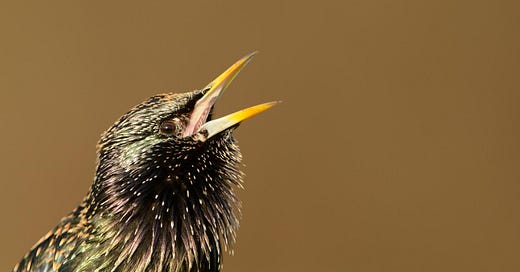Region bucks the national trend for starling sightings
The results are in for almost 20,000 North East observers who took part in the Big Garden Birdwatch. Tony Henderson spots the trends
The North East could be on its way to becoming a refuge for a familiar garden bird which is now in headlong retreat.
The national results of this year’s RSPB Big Garden Birdwatch show that the starling has dropped out of the top three most seen species for the first time, with numbers the lowest ever recorded.
The UK breeding population declined by 82% between 1970 and 2022. Prior to 2000, the starling was regularly the most numerous species recorded in the Big Garden Birdwatch.
Almost 20,000 spotters rook part in the Birdwatch in January in the North East.
Their findings showed that the starling bucked the national trend and topped the sightings league in Tyne and Wear and Tees Valley, demoting the house sparrow into second place.
However, the breeding starling population in the North East has declined by 56% between 1995 and 2022.
Last year the house sparrow was the top bird observed across the region’s gardens and green spaces.
Starlings are now a red listed species in the UK and considered a high conservation concern due to their declining numbers.
RSPB chief executive Beccy Speight said: “Starlings are one of our most charismatic garden birds, but this year’s Big Garden Birdwatch results are a reason for concern.
“With one in six species at risk of extinction from Britain, we’ve done more damage to our natural world than we realise. However, we can all do our bit to support these threatened birds by taking small actions that can not only benefits starlings, but other garden wildlife.”
Starlings can be helped by avoiding the use of pesticides and keeping a natural lawn which allows the birds to forage for invertebrates, especially leatherjackets (cranefly larvae).
They also need short grass to watch out for predators while feeding. Nest boxes also help with a 45mm entrance hole the ideal size.
The woodpigeon’s colonisation of urban areas was highlighted in this year’s results with the species in third place in Tyne and Wear, ahead of the blackbird in fourth and blue tit in fifth, while the feral pigeon came sixth.
The woodpigeon was also fourth in Tess Valley, fifth in Northumberland and County Durham and third nationally.
The regional breakdown was:
Northumberland
House sparrow
Starling
Blackbird
Blue tit
Woodpigeon
Chaffinch
Robin
Goldfinch
Jackdaw
Great tit.
Tyne and Wear
Starling
House sparrow
Woodpigeon
Blackbird
Blue tit
Feral pigeon
Magpie
Robin
Goldfinch
Jackdaw.
County Durham
House sparrow
Starling
Blackbird
Blue tit
Woodpigeon
Jackdaw
Robin
Great tit
Goldfinch
Magpie.
Tees Valley
Starling
House sparrow
Blackbird
Woodpigeon
Blue tit
Feral pigeon
Robin
Goldfinch
Magpie
Great tit.
Nationwide, almost 600,000 people took part in the world’s largest garden wildlife survey, counting more than nine million birds of over 80 species.
Gardens, an increasingly important habitat for many species, are often overlooked but cover an estimated 4,330 square kilometres. In England alone, the land area given over to gardens is more than four and a half times larger than that of the country’s National Nature Reserves.





